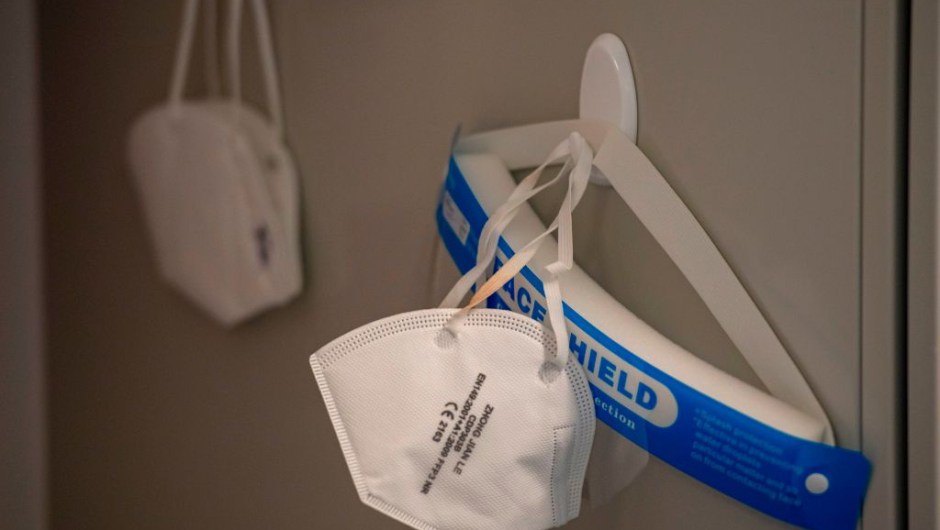Wearing two masks, does it help protect you from the coronavirus?
3:19
(CNN Spanish) -
Using two masks, or wearing a tighter surgical mask, could significantly reduce the transmission of the coronavirus, according to a new recommendation from the United States Centers for Disease Control and Prevention.
In this episode, Dr. Elmer Huerta analyzes the experiment that led to this recommendation.
You can listen to this episode on Apple Podcasts, Spotify, or your favorite podcast platform, or read the transcript below.
Hello, I am Dr. Elmer Huerta and this is your daily dose of information on the new coronavirus.
Information that we hope will be useful to take care of your health and that of your family.
CDC recommends wearing two masks
Today we will see why the Centers for Disease Control and Prevention (CDC) now recommends wearing a better fitting surgical mask, or a double mask in the midst of the current covid-19 pandemic.
advertising
As we have heard during several episodes of this podcast, the use of masks has gone through several stages during the pandemic.
It was thought that - like the flu - contagion was mainly from the thick drops that are released when coughing or sneezing.
In the beginning, the masks were only recommended for people with symptoms, and their use by people without symptoms was not encouraged.
The effective use of masks
It was not until April 3, 2020 that the CDC changed its recommendation, asking that the masks be used by the population in the United States.
And on June 5 last year, the World Health Organization called for the use of masks to be encouraged in areas where the spread of the coronavirus continues to be intense.
The reason for this change was that it was scientifically demonstrated that the main route of infection of SARS-CoV-2 was not only the thick droplets produced by coughing or sneezing, but the aerosols, microscopic particles that are produced only by talking, shouting or singing .
1 of 8
|
N95: When fitted to the user's face and used correctly, N95-type masks can trap 95% of particles around 0.3 microns.
Dr. Abraar Karan told CNN that if all Americans wore this type of mask it would "stop the epidemic."
But be careful with N95 masks with exhalation valves, as they return airflow to the environment.
And also with the imitation N95s.
(Photo: Justin Sullivan / Getty Images)
2 of 8
|
FFP2-FFP3: Some European countries require the use of FFP1 and FFP2 masks, which stand for "filter mask respirator".
An FFP1 filter has a minimum filtration efficiency of 80%, an FFP2 is 94% effective, and an FFP3 is 99% effective against airborne infectious diseases.
(Photo: LENNART PREISS / AFP via Getty Images)
3 of 8
|
KN95: They are certified to Chinese standards and also filter and capture 95% of 0.3 micron particles.
But there are differences: the filter layers of N95 respirators were "8 times thicker and had a dipole charge density 2 times that of KN95 respirators," according to a study published in December.
(Photo: Sean Gallup / Getty Images)
4 of 8
|
Surgical: Designed for use by surgeons and other healthcare professionals, surgical grade masks are loose, disposable devices;
they do not "filter or block very small airborne particles that can be transmitted by coughing, sneezing or certain medical procedures," the FDA stressed.
Surgical masks are for single use only, and if they are dirty or breathing is difficult, the mask should be disposed of and replaced carefully, the FDA said.
(Photo: GEORGES GOBET / AFP via Getty Images)
5 of 8
|
Of fabric: The effectiveness depends on the type of fabric used and the number of layers.
They can be only 26% effective.
According to the CDC, "Multiple layers of fabric with higher yarn counts have demonstrated superior performance compared to individual layers of fabric with fewer yarns, in some cases filtering almost 50% of fine particles less than 1 micron ".
(Photo: GABRIEL BOUYS / AFP via Getty Images)
6 of 8
|
Double mask: To increase their chances, people have started to put cloth masks over surgical ones for added protection.
In the photo, the candidate for Secretary of Transportation, Pete Buttigieg.
(Photo: Stefani Reynolds - Pool / Getty Images)
7 of 8
|
Collars / Scarves / Leggings: Don't wear knitted scarves or balaclavas for protection, the CDC says.
Don't use a face shield without a mask, the agency cautions, as it won't protect against the tiny airborne droplets that can float under and in the shield.
And forget about kerchiefs and scarves.
(Photo: JAVIER SORIANO / AFP via Getty Images)
8 of 8
|
If you're using a fabric mask, use the light test to check the fabric - if you can easily see the outline of individual fibers when you hold the mask up to the light, it probably won't be effective.
"A surgical mask with a cloth mask on top can achieve a particle removal efficiency of greater than 91%," said Professor Joseph Allen of the Harvard TH Chan School of Public Health.
(Photo: CHRIS DELMAS / AFP via Getty Images)
Since then, despite knowing that the use of masks is a very effective measure in protecting the population from contagion by the new coronavirus, in some countries - such as the United States and Brazil - their use has become politicized and segments of the population have not. they used.
The use of masks can make those who contract covid-19 asymptomatic
In this regard, as we saw in the episode of October 28, researchers from the University of California postulated that the use of masks would act as an element of variolization, that is, if a person becomes infected using a mask, the viral load it would be so little that it ends up causing an asymptomatic form of the disease.
In this sense, they mention that in societies where the use of masks is almost universal, the proportion of asymptomatic cases is more than 80%.
While in societies where the use of masks is not widespread, the proportion of asymptomatic cases is 40%.
The importance of wearing two masks or a tight-fitting surgical mask
And this Wednesday the CDC has released its latest recommendations regarding the use of masks.
They advise that wearing a tight-fitting surgical mask, or wearing two masks, can significantly reduce the transmission of COVID-19.
And so the spread of new, more contagious variants can be delayed.
In a study published in the CDC's Morbidity and Mortality Weekly Report, researchers report that if two people wear a surgical mask, in which the loop that goes to the ear is tied at the end facing the mask so that fits the face well, or if you both wear a double mask, a cloth over a surgical mask, exposure to viral particles is reduced by more than 95%.
Data revealed by the experiment
In a simulated breathing experiment, it was shown that the use of a surgical mask could block 42% of the particles originated by an aerosol simulator in the model.
While the use of a cloth mask blocked just over 44% of the aerosols.
But if two masks are used, a cloth one over a surgical one, the protection in the model is increased, blocking up to 92% of the aerosols.
Variants of covid-19
Undoubtedly, these findings are very important, because as we saw in the January 25 episode, given the appearance of more contagious variants of SARS-CoV-2, some European countries have ordered that their inhabitants wear N95 masks instead of the of fabric.
In the absence of an N95 mask, the CDC's recommendations are important as more people will be able to get and use a combination of surgical and cloth mask.
Let us remember, as we saw in the episodes of January 27, 28 and February 8, that variants B.1.1.7, discovered in the United Kingdom and B.1.351, discovered in South Africa, being more infectious, and cause more cases, can cause more deaths, and can even be resistant to current vaccines and cause reinfections.
So far these variants have not been proven to cause more lethal diseases.
Fit the mask well to work
In summary, wearing one N95 mask or two masks, one cloth over one surgical, can significantly reduce infection by new strains of the coronavirus.
But the important thing, as the director of the CDC said, is that they are well adjusted and do not leave open spaces for the virus to enter.
That is, not only do you need to wear masks, but they need to be used correctly.
Do you have questions about covid-19?
Send me your questions on Twitter, we will try to answer them in our next episodes.
You can find me at @DrHuerta.
If you think this podcast is useful, help others find it by rating and reviewing it on your favorite podcast app.
We will be back tomorrow so be sure to subscribe to get the latest episode on your account.
And for the most up-to-date information, you can always head to CNNEspanol.com.
Thanks for your attention.
If you have any questions you can send them to Dr. Elmer Huerta via Twitter. You can also head over to CNNE.com/coronaviruspodcast for all episodes of our "Coronavirus: Reality vs. Reality" podcast. fiction".
CDC Masks









